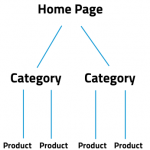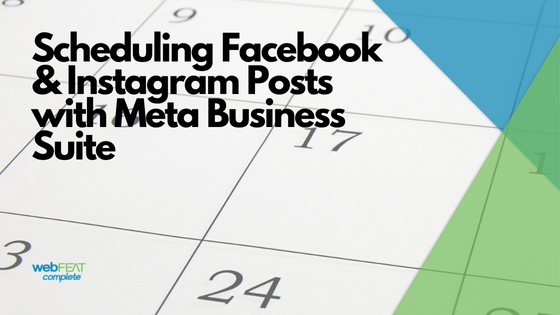Would you rather listen to a podcast about this? Check it out!
We are back with Part 2 of our E-Commerce SEO strategy series. We will be getting a bit more technical this week, but these are three essential components to making your e-commerce website rank in the search results. URL structure, strategic links, and backlinks are some of the most important SEO factors that can help you outperform your competition. Without further ado, let’s jump in.
URL Structure
From a technical SEO standpoint, e-commerce URL structure is essential for ranking your products on Google. The easier it is for Google to understand your website’s hierarchy, the better they can understand your website and satisfy user intent, and the more likely your website is to rank on page 1. URL structure involves every page of your website from the home page and product pages, to blog posts and beyond. Depending on the size of your website and the amount of products you have, optimizing your URL structure can vary in difficulty. Regardless, it is essential and should be taken care of sooner rather than later.
Best Case Scenario
The best case scenario is to plan out the structure of your website during the design process and before your website is published to the web. This way, you won’t have to worry about implementing too many redirects and putting your hard-earned SEO juice at risk. This is really a rare situation because overtime, website URL structures will likely change as more products and categories are added and you may want to experiment with a different URL structure to improve performance.
URL Structure Best Practices
- The shorter the better. You want your main product keywords to be as close to the root domain (example.com) as possible. This can be done by being strategic with your product URL structure and omitting unnecessary articles from your URLs such as “a”, “and”, and “the”.
- Use hyphens.
- Your product URLs should look like this: example.com/shoes/red-nike-shoes/
- not like this: example.com/shoes/rednikeshoes/
- Utilize breadcrumbs throughout your e-commerce website. You’ve seen breadcrumbs before whether you realize it or not. Breadcrumbs are links at the top of e-commerce pages showing the hierarchical path to a specific product. If you are looking to buy a new coffee table the breadcrumbs might look something like this:
Updating URLs for a Published Website & 301 Redirects
If you are looking to update the URL structure of your e-commerce website, you must learn about 301 redirects. These are a simple tool for passing all of your SEO juice from a current URL to a new URL. Essentially, if you have a page showing up in the search results and change that page’s URL, you need to implement a 301 redirect so that 1) user’s aren’t taken to a broken 404 page and 2) you maintain the majority of SEO value for that page. Depending on your website’s platform there are plugins to take care of these fairly quickly or you can have your developer implement them.
Finally, the question you’ve probably been wondering all along…
What’s the Best E-commerce URL Structure?
Like most SEO strategies, there isn’t a simple answer here, but let’s go over a standard e-commerce example for a small, niche e-commerce website. A good URL structure looks something like this:
Home Page: example.com
Product Categories: example.com/category/
Product Pages: example.com/category/product
For the visual learners out there, here is a simple graph:

Setting up a URL structure like this helps Google understand what pages are for high level searches and what pages are for more focused, high-intent phrases. If someone searches for “dress shoes for men” Google is likely going to show Category pages in the search results, whereas if someone searches for “tan clark dress shoes size 11”, Google will likely show an actual product page. This is just one reason why setting up your website using a solid URL structure can really improve your SEO and overall website performance.
Each website’s URL structure is going to vary. If you are feeling overwhelmed and want to ensure you have a strong structure in place, get in touch with an expert and set your e-commerce store up for success!
Strategic Linking and Anchor Text
Another simple, but effective SEO e-commerce strategy is strategic linking throughout your website. The idea behind links is to give Google clues about the most important pages on your website. Strategic links can be placed in blog posts, on product pages, and just about anywhere on your website. A great strategy any website can benefit from is to consistently write good content in the form of blog posts and link back to your home page, category pages, and product pages using relevant anchor text. Anchor text is the keyword or keywords linking to another page on your website.
Example
Let’s say you run an e-commerce store selling high dollar baseball cards. You might write a blog post discussing the history of one of the original baseball card manufacturers and within the blog you discuss a particular card that just so happens to be available on your website. You could implement strategic links using solid anchor text like this:
The Johnny Bench 1976 Limited Edition World Series card was originally produced by Topps in New York City.
The “Johnny Bench 1976 Limited Edition World Series card” text is considered the anchor text. These not only inform readers what the link is about, but they also send clues to Google that the blog post is relevant to Johnny Bench.
It’s important your links are used strategically. You don’t want to be overly spammy and you should make the links serve a purpose. If you link to product or category pages from blog posts, change up the anchor text for each link. So, using the example from above, maybe the next time you link to the Johnny Bench 1976 world series card, your anchor text could say “mint condition 1976 Johnny Bench card”.
Backlinks
What Are They?
In a way, backlinks are similar to strategic links, but they occur on an external website. Backlinks might be the most important element to a strong SEO strategy, but they are also the most difficult to acquire. A backlink is when someone else links to your website from their website. It’s a pretty simple concept really, but they can be difficult to acquire. These most commonly occur on blog posts, but they are just as valuable when used in a podcast description or on an actual webpage.
Why Are They Important?
Backlinks give your website authority by showing Google that other people find your products or services so valuable they are willing to direct users away from their website to your website. The more quality links you have to your website, the more likely you are to rank for high volume keywords and outperform your competition. A quality link comes from web content that is relevant to your industry and business, is supported by other valuable content, and comes from a high authority/well-respected business or influencer.
How Do I Acquire Backlinks for My Website?
There are many ways to do this, but let’s go over a few:
- Organic Backlinks: this occurs when someone genuinely enjoys your products and naturally links to your website from their website or blog. There’s really no work required here other than selling a good product that people enjoy and respect.
- Outreach: the most common way to acquire a backlink is to reach out to other websites and ask them to link to your site. This can take quite a bit of work and rejection, but if you land a backlink from a big name in your industry with a well respected website it can do wonders for your rankings. A good strategy during your outreach, is to offer some type of value to your prospects. Offer to give them a backlink in return, provide them with useful content or infographics that could benefit their customers, or give them your product for free to sample and write a review.
- Share Content and Infographics on Social Media: Although simply posting an article on Facebook will not earn you a backlink, it improves your chances of someone else enjoying your post so much that they decide to share it on their own blog or website. When posting content on social media, social platforms use something called a no-follow tag that essentially tells Google not to pass any SEO juice back to the website being linked.
Paid Services to Incorporate with SEO
SEO is essential for your online business, but that doesn’t mean you shouldn’t be implementing other marketing strategies. A great way to support your e-commerce business and generate sales quickly is through Cost Per Click (CPC) Advertising. Two of the most common platforms for CPC Advertising are Google Shopping Ads and Facebook Advertising. Google Shopping Ads have a much lower CPC compared to standard text ads and Facebook Advertising is generally affordable and puts your products in front of your desired customers.
I hope you learned a thing or too. I’d love to connect with you and learn more about your business. If you have additional questions you can reach us at teamseo@webfeatcomplete.com.
“”





